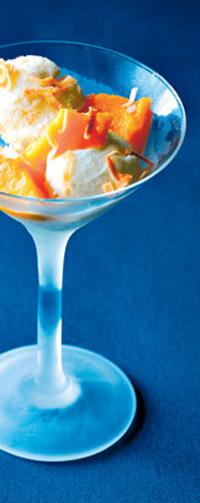
Frozen treats tame the summer heat for cultural groups all over the world. However, they are far from being a fresh idea, or originating from any one ethnicity. King Tang, in China, is rumored to have enjoyed ice and milk concoctions during the first century A.D. Emperor Nero is known to have eaten mountain ice from the Apennine range, topped with fruit, during the first century A.D. By the mid-1530s, frozen desserts emerged in France, appearing on the streets of Paris by 1700 before spreading to England and other European countries.
Presidents George Washington and Thomas Jefferson were among the first to serve frozen desserts in the United States. The first U.S. ice cream parlor opened in 1776, the first patented hand-cranked freezer was developed in the 1840s, and the first large-scale ice cream manufacturing plant began operations in 1851. Approximately 70 years later, shaved ice, or ‘snow cones’ debuted at the Texas state fair.
Today, icy desserts are available throughout the world. Japanese kakigori combines shaved ice with fruit and green tea-flavored syrups. Often sweetened with condensed milk, kakigori is a favorite street food at festivals, convenience stores, coffee shops, and available everywhere during the summer months. Filipinos combine shaved ice with condensed or evaporated milk, boil sweet beans, and fruits to create halo halo.
Originally conceived in the Middle East, charbet, or sorbet – a fruit juice and water combination – may consist of sweetened water with iced fruit, chocolate, wine or liqueur. North Africa’s version of sorbet, agraz, includes almonds, sugar, and highly acidic juice made from grapes.
Kulfi is one of India’s favorite ‘street foods,’ where it is most often served on a stick, says Varsha Patel, co-owner with her husband, Pradeep, of India Café in Overland Park, KN. “Indian people like desserts after dinner and kulfi is allowed during fasts. In the restaurant, we put cherries on it, fresh or maraschino, and rose water on top.”
Varsha occasionally makes mango kulfi, but the restaurant usually serves Pista Kulfi – a combination of heavy cream, condensed and evaporated milk and whipped topping with crushed cardamom and pistachios.
A Hispanic-American street food, paletas (pah – LET – ah) is gaining devoted fans throughout the country. Traditional fruit and vegetable-based paletas feature bits of mango or cucumber combined with chili powder, guava, pineapple, tamarind, and juice made with a water base. Creamy versions of the sweet treat, such as coconut, vanilla, chocolate, rum, and arroz con leche (a rice pudding flavor) are made with milk, instead.
At Las Paletas in Nashville, co-owners and sisters, Norma and Irma Paz, sell only the beloved paletas they grew up with in their Hispanic culture. “It’s a healthy food made with fresh ingredients,” Norma says. “It tastes exactly like the fruit.”
The Paz sisters handcraft every paleta, including scraping mango pulp by hand before adding a bit of sugar for emulsification. They also blend half a batch of strawberry chunks before freezing the strawberry mixture onto a stick like a traditional American Popsicle. ‘”It takes you back to childhood,” Norma says. “There isn’t a certain demographic, there are college kids (looking for) a snack and businessmen after work.”
Gelato is the Italian word for ‘ice cream’ but its consistency differs from ice cream because it is stirred while frozen. This breaks up ice crystals, resulting in a very dense and flavorful dessert. Argentinean and French ‘culinary cousins’ of gelato are helado and glace.
Mondo Gelato has operated in San Diego for about a year. One of eight locations from Vancouver to Hawaii, China, and Rome, the company offers Italian gelato with half the fat and calories of ice cream and a quarter less sugar. Their sorbets are made with local fruit.
“We have 38 flavors that rotate,” says managing partner, Nathaniel Uy. “(Our motto is) ‘One world, many flavors.”
Flavors range from hazelnut to chocolate. Persian and Indian customers particularly appreciate a rose-colored, water-flavored gelato – a combination inspired by Italian candies.
The next time you’re looking for culinary relief from summer heat, check out a new dessert with an international flare.
Coconut Gelato
(Recipe courtesy of Mondo Gelato)
1 can (400 milliliters) coconut milk
2.5 liters whole milk
700 grams sugar
200 grams coconut flakes (use for layering)
Whisk together first three ingredients and pour in gelato/ice cream machine. Once frozen and extracted, layer with coconut flakes.
